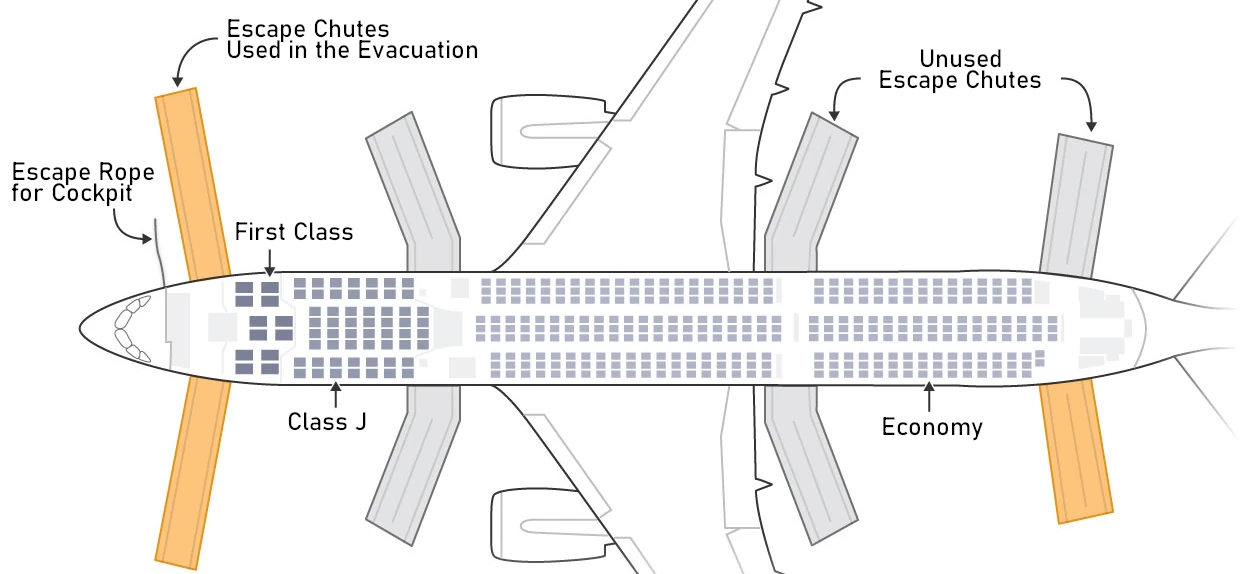Increase Legroom on Every Flight
The Federal Aviation Administration (FAA) requires that, in an emergency, all aircraft and seat configurations are able to evacuate the plane in less than 90 seconds. Airlines routinely have to demonstrate this, especially whenever they change seat configurations on their planes. This typically happens without any problem for a couple of reasons. First, the airline does run this test on their own before the FAA participates. If there are problems, they'll make adjustments as necessary to get the evacuation time to under 90 seconds. Second, and more troublesome, is that the airlines use a plane is full with passengers who are meticulously selected for their small size, short height, and excellent health.
One has only to board a plane from literally anywhere in the United States to Las Vegas, NV to find a plane being loaded with many senior citizens who, God bless them, are not as fast as they used to be. Additionally, 42% of Americans are obese. Furthermore, while not as predominant as obesity in the United States, 3.9% of men are taller than 6'-2" and can't even stand up normally in most aircraft; if they can even fit in a normal economy seat. Despite these facts, the plane evacuation tests don't include disabled, senior citizens, the morbidly obese, or freakishly tall. This is a seriously dangerous and potentially deadly mistake.
For example, on January 2, 2024, a Japanese coast guard plane providing earthquake relief collided with an Airbus A350: Japan Airlines flight JAL-516 with 376 souls on board. From the time of collision; which is when the 90-second evacuation clock is supposed to start; it took 18 minutes to evacuate the plane. That's 12 times longer than 90 seconds! In the interest of fairness, it took the plane some time to come to a complete stop and the crew struggled for about three minutes to determine which emergency exit doors could be opened safely. However, by all accounts, once the doors were opened, the evacuation itself still took over 10 minutes. This particular flight had 376 on board, but the plane itself was configured to hold either 391 or 423 passengers (reports said 391, but the aircraft configuration shows 423), not including the crew; so the evacuation could have taken even longer if it was a full flight. Thankfully, no lives were lost in this evacuation, but that's not to say it was a safe evacuation as the cabin was filled with smoke and the chute at the rear of the plane had to stop service because the smoke outside the plane had gotten too bad, forcing the people left at the rear of the plane to walk through the smoke filled cabin; which was now starting to catch on fire.

The FAA has a 90 second evacuation rule for a very important reason: a plane filled with jet fuel can burn really fast! JAL-516 experienced a relatively slow burn, but the next plane to be evacuated may not be so lucky.
Steps need to be taken to reduce the number of passengers on flights and increase the legroom between the seats to make it easier for people who are elderly, disabled, obese, or tall to get up, move through the cabin, and escape without slowing down the entire evacuation.
A Personal Note
I'm 6'-6" tall and have a wide frame. In 2002, I was able to sit in any economy seat on an airplane. It may not have been comfortable, but I could make it work. In 2005, I had to begin sitting in exit rows. In 2012, I found that even the exit rows were getting tight for my legs as only one seat next to the exit door had been removed. Finally, in 2022, with my options for seating in economy becoming increasingly limited, I came to the expensive realization that the only way I could fly and know for certain my legs could fit was to fly First Class. I absolutely despise this because I'm not particularly wealthy and it prohibits me from going on a lot of trips that I would like to go on.
Being this tall, I am unable to stand up straight on any flight. I usually have to tilt my head and bend forward or to the side. If I'm on a smaller commuter jet, my shoulders and the back of my head usually drag across the ceiling of the cabin. Getting in and out of my seat is a hassle, too as I have to duck under the overhead baggage bins while simultaneously doing a squat and side shuffle to get to my seat and making sure I won't be sitting on my seat belt. When I get out of my seat, I inevitably begin blocking the entire aisle as soon as I put my elbows out to pick myself out of my seat. I cannot move fast when I'm postured like this, and while I'm sure I would move faster in the event I found myself on a plane that was going up in flames; I still could not move as fast as everyone else and I would slow down the evacuation.
With more legroom, I would be able to get up more naturally, and while I would still not be able to move as fast as I could with a taller cabin, it would be much for efficient for the success of the evacuation if there was just an extra 4" of legroom per seat. That would mean quite a few less seats on a plane, but in a real world evacuation scenario, like we saw on JAL-516, the economy sections in planes need to be much less densely packed than they are now anyway in the event of a faster burn or imminent explosion on the plane.







